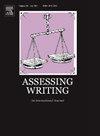Detecting and assessing AI-generated and human-produced texts: The case of second language writing teachers
IF 5.5
1区 文学
Q1 EDUCATION & EDUCATIONAL RESEARCH
引用次数: 0
Abstract
Artificial intelligence (AI) technologies have recently attracted the attention of second language (L2) writing scholars and practitioners. While they recognize the tool’s viability, they also raised the potential adverse effects of these tools on accurately reflecting students’ actual level of writing performance. It is, therefore, crucial for teachers to discern AI-generated essays from human-produced work for more accurate assessment. However, limited information is available about how they assess and distinguish between essays produced by AI and human authors. Thus, this study analyzed the scores and comments teachers gave and looked into their strategies for identifying the source of the essays. Findings showed that essays by a native English-speaking (NS) lecturer and ChatGPT were rated highly. Meanwhile, essays by an NS college student, non-native English-speaking (NNS) college student, and NNS lecturer scored lower, which made them distinguishable from an AI-generated text. The study also revealed that teachers could not consistently identify the AI-generated text, particularly those written by an NS professional. These findings were attributed to teachers’ past engagement with AI writing tools, familiarity with common L2 learner errors, and exposure to native and non-native English writing. From these results, implications for L2 writing instruction and future research are discussed.
检测和评估人工智能生成的文本和人类制作的文本:以第二语言写作教师为例
人工智能(AI)技术最近引起了第二语言(L2)写作学者和从业人员的关注。他们在肯定这一工具可行性的同时,也提出了这些工具对准确反映学生实际写作水平的潜在不利影响。因此,对于教师来说,如何将人工智能生成的作文与人类的作品区分开来以进行更准确的评估至关重要。然而,关于教师如何评估和区分人工智能和人类作者的作文的信息却很有限。因此,本研究分析了教师给出的分数和评语,并研究了他们识别作文来源的策略。研究结果显示,英语为母语(NS)的讲师和 ChatGPT 撰写的论文获得了很高的评分。与此同时,由以英语为母语的大学生(NS)、非以英语为母语的大学生(NNS)和非以英语为母语的讲师撰写的论文得分较低,这使他们可以与人工智能生成的文本区分开来。研究还显示,教师无法一致地识别人工智能生成的文本,尤其是那些由 NS 专业人员撰写的文本。这些发现归因于教师过去使用过人工智能写作工具,熟悉第二语言学习者的常见错误,以及接触过母语和非母语英语写作。根据这些结果,我们讨论了对 L2 写作教学和未来研究的影响。
本文章由计算机程序翻译,如有差异,请以英文原文为准。
求助全文
约1分钟内获得全文
求助全文
来源期刊

Assessing Writing
Multiple-
CiteScore
6.00
自引率
17.90%
发文量
67
期刊介绍:
Assessing Writing is a refereed international journal providing a forum for ideas, research and practice on the assessment of written language. Assessing Writing publishes articles, book reviews, conference reports, and academic exchanges concerning writing assessments of all kinds, including traditional (direct and standardised forms of) testing of writing, alternative performance assessments (such as portfolios), workplace sampling and classroom assessment. The journal focuses on all stages of the writing assessment process, including needs evaluation, assessment creation, implementation, and validation, and test development.
 求助内容:
求助内容: 应助结果提醒方式:
应助结果提醒方式:


